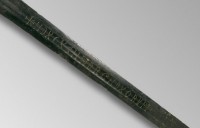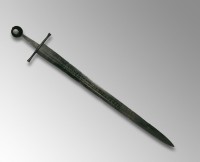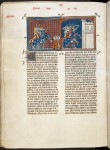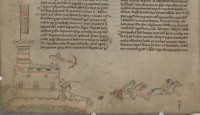 I’m asking for a friend. (The British Library is my friend, right?) On display at the British Library’s Magna Carta: Law, Liberty, Legacy exhibition is a medieval double-edged sword made of steel with an inlaid gold wire inscription on one side. The inscription appears to read:
I’m asking for a friend. (The British Library is my friend, right?) On display at the British Library’s Magna Carta: Law, Liberty, Legacy exhibition is a medieval double-edged sword made of steel with an inlaid gold wire inscription on one side. The inscription appears to read:
Experts haven’t been able to decipher this mysterious assortment of letters, so the British Library’s phenomenal Medieval Manuscripts blog is opening up the floor to the Internet. Some think it was a religious dedication of some kind using the first initials of words. There are inscribed crosses on the other side and an inlaid crescent near the point on both sides which may be the maker’s mark.
 The sword was discovered in the River Witham, Lincolnshire, in July of 1825 by workers widening and deepening the river just below the lock to make room for larger vessels. The Bishop of Lincoln gave the sword to the Royal Archaeological Institute which in 1858 donated it to the British Museum. It dates to around 1250-1330 and has a straight cross guard with a wheel-shaped pommel atop the grip. Weighing 2 lb 10 oz and measuring 38 inches long, the sword was a killer, capable of cleaving a man’s skull in two.
The sword was discovered in the River Witham, Lincolnshire, in July of 1825 by workers widening and deepening the river just below the lock to make room for larger vessels. The Bishop of Lincoln gave the sword to the Royal Archaeological Institute which in 1858 donated it to the British Museum. It dates to around 1250-1330 and has a straight cross guard with a wheel-shaped pommel atop the grip. Weighing 2 lb 10 oz and measuring 38 inches long, the sword was a killer, capable of cleaving a man’s skull in two.
This kind of sword was a classic knightly weapon of the 13th century and is depicted in many an effigy and illustration. Here’s an example from the British Library’s 14th century illuminated manuscript of the Grandes Chroniques de France in which French knights besiege Rouen in 1203/1204 during King Philip Augustus’ invasion of Normandy.
 In fact, the sword was believed to have a very close connection to French knights from that turbulent period. When the sword was first discovered, workers found other armature — swords, daggers, chain mail — in the muck of the riverbed leading to speculation that these were the remains of French knights who had drowned in the river after the Second Battle of Lincoln in 1217. When the First Barons’ War broke out between King John and his nobles in 1215 after John refused to abide by the terms of Magna Carta, the barons invited Prince Louis of France to take the throne of England. He accepted and turned up with an army in May of 1216. Louis waltzed into London unopposed and was proclaimed king in a ceremony at St. Paul’s Cathedral. He doesn’t make the official king list because he was never crowned, but for a while in 1216-1217 the Dauphin of France actively occupied half of England.
In fact, the sword was believed to have a very close connection to French knights from that turbulent period. When the sword was first discovered, workers found other armature — swords, daggers, chain mail — in the muck of the riverbed leading to speculation that these were the remains of French knights who had drowned in the river after the Second Battle of Lincoln in 1217. When the First Barons’ War broke out between King John and his nobles in 1215 after John refused to abide by the terms of Magna Carta, the barons invited Prince Louis of France to take the throne of England. He accepted and turned up with an army in May of 1216. Louis waltzed into London unopposed and was proclaimed king in a ceremony at St. Paul’s Cathedral. He doesn’t make the official king list because he was never crowned, but for a while in 1216-1217 the Dauphin of France actively occupied half of England.
 The tide turned when King John died in October of 1216. Even though John’s son Henry was only nine years old, barons who had sided with Louis switched sides in droves. William Marshal, “the greatest knight that ever lived,” was Henry’s regent and fought at the head of his army, drawing more knights to abandon Louis for Henry. On May 20th, 1217, forces loyal to the nine-year-old King Henry III of England attacked the city of Lincoln, then held by the French. The English held Lincoln Castle, however, so while Marshall’s army took the north gate of the city, Falkes de Breauté deployed his crack crossbowmen along the castle ramparts to rain a hellfire of bolts into the French occupiers. It was a rout, followed by a very thorough pillaging of the city that has gone down in history as the Lincoln Fair. French knights who weren’t killed or captured fled, some of them sailing down the Witham. Some of the ships, laden with men, arms and armour, sank drowning the flower of French chivalry and, ostensibly, leaving their stuff behind for canal diggers to find 600 years later.
The tide turned when King John died in October of 1216. Even though John’s son Henry was only nine years old, barons who had sided with Louis switched sides in droves. William Marshal, “the greatest knight that ever lived,” was Henry’s regent and fought at the head of his army, drawing more knights to abandon Louis for Henry. On May 20th, 1217, forces loyal to the nine-year-old King Henry III of England attacked the city of Lincoln, then held by the French. The English held Lincoln Castle, however, so while Marshall’s army took the north gate of the city, Falkes de Breauté deployed his crack crossbowmen along the castle ramparts to rain a hellfire of bolts into the French occupiers. It was a rout, followed by a very thorough pillaging of the city that has gone down in history as the Lincoln Fair. French knights who weren’t killed or captured fled, some of them sailing down the Witham. Some of the ships, laden with men, arms and armour, sank drowning the flower of French chivalry and, ostensibly, leaving their stuff behind for canal diggers to find 600 years later.
Without identifying marks connected to specific knights, this story is impossible to prove. Still, the design and period of the sword make it relevant as a weapon very much like those used during the battles between the English crown and its unruly barons. It’s neat to think that it may even go a step further and be an actually relict of the First Barons’ War.
If you have any ideas about what the inscription might mean, join the party in the comments on the Medieval Manuscripts blog entry where smart people are saying smart things.
i wish we had pics of [1] the reverse side of the sword and [2] the other items recovered at the same time. context very important in arcy as we know.
trouble is, historical riddles result in a paradox:
to solve the riddle, find out the history of the item
to find out the history of the item, solve the riddle!
NDXOXCHWDRGHDXORVI
GOAL OF A GOOD SERVANT WAITING GOD
Here is the key to decipher the inscription:
Taking away all the X’s
ND O CHWDRGHD ORVI
Then we split CHWDRGHD in three seperate pieces.
ND O CHW DR GHD ORVI
It is all written in Welsh apart from ORVI (Latin)
ND should be NOD = goal
O = of
Chw should be CHWAS (probably an abbreviation) = servant
DR should be DA = good
GHD should be Gohd = God
ORVI should be ORUI = Wait(ing)
All words are translated from Welsh to German and then into English.
ORVI is ORUI which can’t be translated directly from Latin into Welsh. As we know it is WAIT I translated wait into Welsh AROS.
If we then translate everything from Welsh to English
+ nod o chwas da gohd aros + becomes ;
GOAL OF A GOOD SERVANT WAITING GOD
Twitter: @codesolver
http://swordinscription.com/index2.html
I truly believe that the transcription is wrong. Just take look at this study: http://www.gustavianum.uu.se/digitalAssets/203/203037_3medieval-christian-invocation-inscriptions-on-sword-blades.pdf . According to picture 29 the 10th letter is not a “R”, but a “N”. And the 11th letter is more likely to be a “C” and not a “G”.
That changes the inscription a bit:
+NDXOXCHWDNCHDXORVI+
More confusing is the “W” though, since there is no “W” in Latin. The used stamp seems to be a “M”, which is just used upside down. Maybe the blacksmith was a bit illitarate? Or he was in a hurry and just made a simple mistake? Or it really is a “W”.In that case it could be a German or Dutch Name. Even heathen god Wodan (WDN) aka Odin is possible.
but if the X are repr of spaces, why would the central section need redividing? this might mean the X are letters after all.
now, we agree this bit LOOKS welsh, and could just plausibly be. but most likely a single word, and still cant think of one.
Glad to see I’m not the only one who read “chowder” into it…
I bet it was made by someone who couldn’t read, therefore spell, and they wanted lettering on it like everyone else. You may need to sound it out and “hear” what it says instead of read it.
I’ve stumbled across this puzzle this morning and have done some very quick research. I was wondering if it is in fact rustic secretary (black letters) used in Roman times and also in Mediaeval writings. I’ve been looking at the image of the letters, and wondered if the two images at each end of the letters aren’t in fact letters themselves. The letter K at the beginning and the letter H at the end. With them having the horizontal line through them I wondered if there was some significance to these letters. Unfortunately, I only had a few minutes to look in to this, but I find it intriguing, and will look in to it some more later.
No
Medieval swords were not heavy at all, And ordinary people could and would wield one with ease, knowing how to use one is a different subject in its own right. The pommel on the sword acts as a counterbalance so the center of gravity is closer to the hand/wrist supporting it. typically between 4.5.6″ from the hilt. Ive nver even heard of a twenty pound sword and doubt one ever even exsisted..,,, (from a swordsmith)
In the Name of the Lord; of the Father and of the Son, and of the Holy Ghost
Count of Holland Willem by the grace of God, King of Germany and Hainault by the will of God Christ reigns! Christ conquers! Christ commands!
Do not accredit this to me.